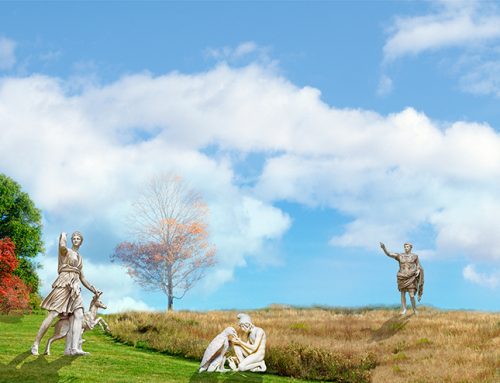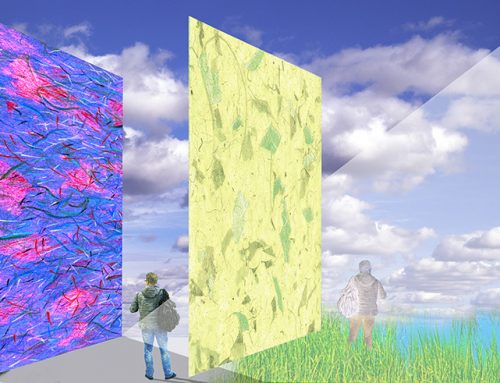Perspective Ballpoint pen on paper by Daniel Heller
Art 101: Definitions
Art 101: Definitions, is a glossary of basic art terms intended to serve as an easy reference point for beginning collectors of art. It is an educational tool offering only the most basic information related to art terms, arranged in alphabetical order. For an in-depth research study, the reader can access the links to the official websites of the major art sources listed below.
A
Abstract – Rendering or painting images and objects in a stylized or simplified way, so that though they remain recognizable, their formal or expressive aspects are emphasized.
Academic – Of or relating to the conservative style of art promoted by an official academy
Aesthetic – Describing a concern or association with beauty or good taste a particular taste or approach to the visual qualities of an object.
Allegory – Allegory in art is when the subject of the artwork, or the various elements that form the composition, is used to symbolize a deeper moral or spiritual meaning such as life, death, love, virtue, justice etc.
Allegorical Painting – the expression by means of symbolic fictional figures and actions of truths or generalizations about human existence.
Americana – Artworks depicting patriotic subjects like famous Americans, historical landscapes, and slices of American life.
Appropriation – Appropriation in visual arts, an intentional borrowing, copying, and alteration of preexisting images and objects, used in the creation of new art
Architecture – The science, art, or profession of designing and constructing buildings, bridges, and other large structures.
Artist – A person engaged in an activity related to creating art.
Avant-garde – A French term that denotes an innovative and experimental group, particularly in the realms of culture, politics, and the arts.
B
Background – The area of an artwork that appears farthest away from the viewer.
Balance – The even distribution of weight, either actual weight or visual weight, in a composition.
Binder – A component of paint (usually liquid) that creates uniform consistency or cohesion.
Brushwork – The manner in which a painter applies paint with a brush.
C
Canvas – Cotton or linen woven cloth used as a surface for painting.
Cartoon – A simple drawing showing the features of its subjects in a humorously exaggerated satirical way.
Classicism – The principles embodied in the styles, theories, or philosophies of the art of ancient Greece and Rome.
Collage – A technique and resulting artwork in which fragments of materials are arranged and glued to a supporting surface.
Color – The perceived hue of an object, produced by the manner in which it reflects or emits light into the eye.
Color wheel – A circular arrangements of hues based on one of a number of various color theories.
Commercial Art – Art made for commerce purposes (advertising, etc.)
Composition – Arrangement of individual elements in an artwork.
Contour – The outline of something.
Culture – The arts and other manifestations of human intellectual achievement regarded collectively
D
Digital art – art creation process in which the artist draws with a stylus on a tablet entering information that is being recorded by an imaging software program, to create a digital file.
Designer – A person who conceives and gives form to objects used in everyday life.
Diptych – A work of art made up of two parts, usually hinged together.
Drawing – the art of marking a surface with various instruments (pencil, crayons, charcoal, pastel etc.) in a manner that leaves an impression on the surface. The type of impressions depending on the artist’s style and could be lines or dots applied in different ways to create shapes forms or patterns. The surface is usually paper.
E
Edition – In printmaking, the number of impressions authorized by the artist made from a single master image.
Etching – A type of print made by scratching marks onto the surface of a metal plate.
Ephemera – Transitory written and printed matter not originally intended to be kept or preserved.
Exposure – The action of exposing a photographic film to light
F
Figurative – Representing a form or figure in the art that retains clear ties to the real world.
Foreground – The area of an image that appears closest to the viewer.
Form – The shape or structure of an object.
G
Genre – A category of artistic practice having a particular form, content, or technique.
Geometric – Resembling or using the simple rectilinear or curvilinear lines used in geometry.
Gouache – An opaque watercolor type of paint.
Giclée – Is a neologism coined in 1991 by printmaker Jack Duganne, for fine art digital prints made on inkjet printers.
Graphic – A visual representation or design on a surface.
H
Hardboard – a Hard surface of compressed and treated wood pulp used as support for painting.
Horizon line – A line in works of art that usually shows where land or water converges with the sky.
Hue – The actual name of a color, such as blue, red, etc.
I
Image – In art a representation of something onto a surface of.
Impressionism – A style of art.
J
Juxtaposition – An act of placing things close together or side by side for comparison or contrast.
K
Kinetic art – Art that physically moves.
L
Lacquer – Any of various clear or colored synthetic organic coatings that typically dry to form a film.
Landscape – The natural landforms of a region; also, an image that has natural scenery as its primary focus.
Lithography – A printmaking technique based on the repulsion of oil and water, in which an oily substance is applied to a stone or other medium to transfer ink to a paper surface.
M
Manifesto – A public declaration, often political in nature, of a group or individual’s principles, beliefs, and intended courses of action.
Medium – Any material used to create a work of art.
Mixed media – A technique involving the use of two or more artistic media, such as ink and pastel or painting and collage.
Monochrome – A work of art rendered in only one color.
N
Narrative – A spoken, written, or visual account of an event or a series of connected events.
Narrative art – Art that tells a story.
Naturalism – Naturalism was a broad movement in the nineteenth century which represented things closer to the way we see them
Negative space – The background or empty space which surrounds a shape so it has a sense of form and volume.
O
Oil Paint – A paint in which pigment is suspended in oil, which dries on exposure to air.
Old Master – A distinguished European artist of the period from about 1500 to the early 1700s’.
Opaque – Impenetrable to the passage of light.
Orientation – May be Horizontal, vertical or diagonal.
P
Paint – A combination of pigment, binder, and solvent (noun); the act of producing a picture using paint (verb, gerund).
Painting – The art of applying paint, watercolor or acrylic colors to a solid surface to create an artwork
Palette – The range of colors used by an artist in making a work of art.
Pastel – A drawing medium of dried paste manufactured in crayon form made of ground pigments and a water-based binder
Passepartout – A sheet material such as cardboard with a cutout. It is used in the art framing industry to frame art drawings or photographs.
Photography – The practice craft or art, of producing images by the action of radiant energy on a sensitive surface (film, an optical sensor).
Pigment – A substance, usually finely powdered, that produces the color of any medium. When mixed with oil, water, or another fluid, it becomes paint.
Portrait – A representation of a particular individual.
Print – A term describing a wide variety of techniques used to produce multiple copies of an original design.
R
Renaissance – A term meaning rebirth or revival; applied to a period characterized by the humanistic revival of classical art, architecture, literature, and learning, originating in Italy in the fourteenth century and later spreading throughout Europe and lasting through the sixteenth century.
Representation – The visual portrayal of someone or something.
Rendering – A representation, executed in perspective, of a proposed structure.
Representational – Portrays natural objects in recognizable form (an example of realism).
S
Scale – The ratio between the size of an object and its model or representation, as in the scale of a map to the actual geography it represents.
Shade – In painting, a color plus black.
Sketch – A rough or unfinished version of any creative work.
Style – A distinctive or characteristic manner of expression.
Subject – The person, object, event, or idea on which an artwork is based
Symbol – A form, sign, or emblem that represents something else.
T
Technique – The method with which an artist employs technical skills or materials to achieve a finished artwork.
Tempera – A type of paint in which pigment is mixed with a water-soluble binder, such as egg yolk.
Triptych – A work of art consisting of three parts, usually hinged together.
W
Watercolor – A paint composed of pigment mixed with water.
Sources
MOMA Glossary of Terms – Official Website
One of the best resources is offered by the UK Tate Gallery (Art Terms) – Official Website
Art terms Glossary: The Essential Vermeer, dedicated to the Dutch painter Johannes Vermeer – Official Website
Suggested reading
Dictionary of art terms and techniques – Amazon Book
Is Photography Art? artgreeT Blog
Abstract artgreeT Blog
Allegory artgreeT Blog
Art Styles artgreeT Blog
Art and prints artgreeT Blog
Passepartout artgreeT Blog






